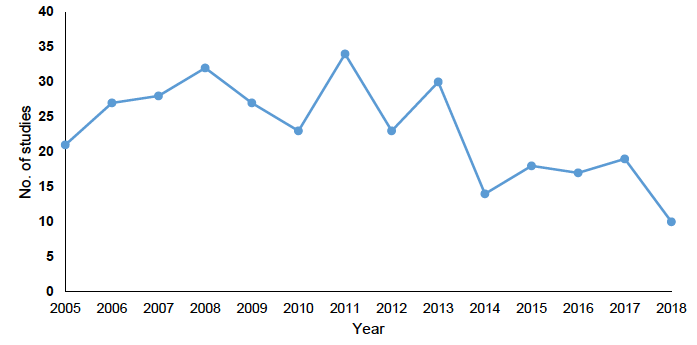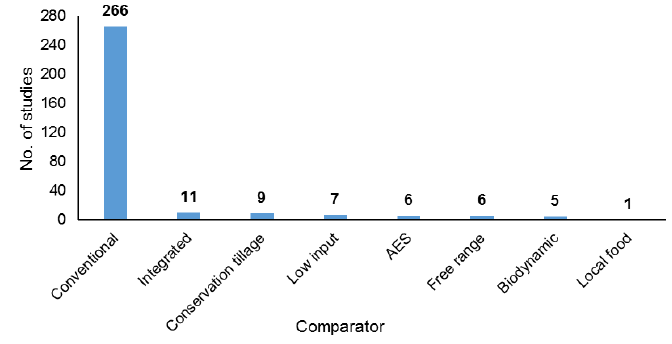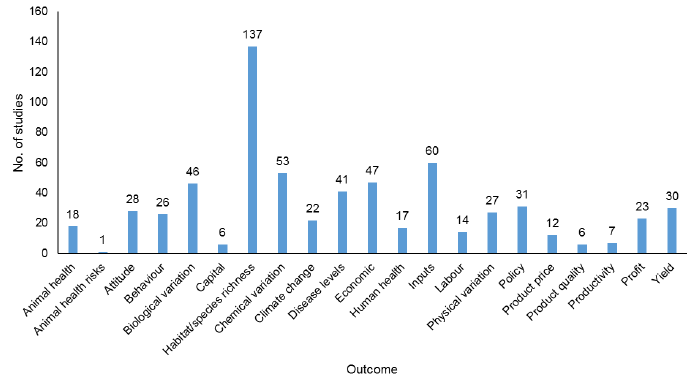Review of the environmental and socio-economic barriers and benefits to organic agriculture in Scotland
Report of the research carried out by Harper Adams University, on behalf of the Scottish Government, into the environmental and socio-economic barriers and benefits to organic agriculture in Scotland.
2. Rapid Evidence Assessment of the benefits and impacts of organic agriculture in Scotland
2.1. Introduction to the Rapid Evidence Assessment (REA)
A rapid evidence assessment of academic and grey literature was carried out to address the following questions:
Primary question:
‘What is the available evidence for the environmental and socio-economic benefits and impacts of organic agriculture versus conventional farming systems in Scotland?’
The question was broken down into a population, intervention, comparator and outcome (PICO) framework to support this process (Table 1).
Table 1: Question elements of the Rapid Evidence Assessment
| Population | Environment, Social-economy, Economy, Consumers, Farmers |
|---|---|
| Intervention | Organic agriculture |
| Comparator | Conventional agriculture/alternative non-organic agriculture |
| Outcome | Changes in the: environment (e.g. climate change, soil, water, soil erosion); social-economy (e.g. employment, rural development), and economy (e.g. rural economy). Public (consumer, farmer & grower) attitudes, behaviours and drivers towards organics, and solutions to increase demand and production |
Secondary questions:
1. What factors determine public attitudes and behaviours towards organic produce and influence consumer demand?
2. What factors have led to a decline in organic certified land in Scotland?
2.2 Scope of the REA
All retrieved studies were assessed for relevance using inclusion/exclusion criteria developed in collaboration with funders and subject experts as follows:
Relevant subjects: Studies that investigate the evidence for the environmental (e.g. biodiversity, soil health, climate change etc) and socio-economic (e.g. rural economy) benefits and impacts of organic agriculture compared to conventional farming systems in Scotland. Subjects for the secondary questions include factors affecting public attitudes and behaviours towards organic produce and the decline in organic certified land in Scotland.
Relevant types of study: Primary research and grey literature reports..
Geographical limits (primary question): The primary question focused on temperate countries with similar farming systems to the UK: Northern European countries (e.g. Austria, Belarus, Belgium, Czech Republic, Denmark, Estonia, Finland, France, Germany, Holland, Hungary, Ireland, Latvia, Liechtenstein, Lithuania, Luxemburg, Norway, Poland, Romania, Serbia, Slovakia, Slovenia, Sweden, Switzerland, UK, Ukraine); northern states of the USA, Canada and New Zealand.
Geographical limits (secondary question 1): The first secondary question focussed on Northern European countries as listed above.
Geographical limits (secondary question 2): The second secondary question focussed on Scotland only.
Farming types: cereal crops (wheat, oats, barley, oilseed rape, maize), potatoes, root vegetables, fresh produce, soft fruits, pasture and livestock systems
Language: Studies published in the English language
Date of Publication: No date restrictions
2.3 Method for the REA
The REA was conducted following Defra/Natural Environment Research Council (NERC) guidelines for the production of Quick Scoping Reviews and Rapid Evidence Assessments (Collins et al, 2015).
2.3.1. Scoping search
An initial scoping search was performed to validate the methodology. Keywords were tested for specificity and sensitivity using the online database ISI Web of Knowledge (Table 2). A wildcard (*) was used to pick up multiple word endings. For example, water* picks up water and waters. Keywords were also made more restrictive by the addition of a qualifier, or multiple qualifiers. A full list of the searches performed during initial scoping and the number of hits achieved is located in Appendices
Appendix 1.
2.3.2. Searches
Following discussion with the Scottish Government and the Review Team, the final search string used was:
(“Organic farm*” OR “Organic agricultur*”) AND (Environment* OR Water* OR Soil* OR Biodiversity OR “Climate change” OR "rural econom*" OR Consumer* OR Farm*)
Online literature databases, the first 50 hits of search engines, and websites of relevant organisations (Table 2) were searched with keywords to identify relevant literature. Other specific/specialised databases were searched where identified or recommended by experts within the field. Database and repository searches were conducted in the English language.
The results of each search term on each database were imported into a separate EndNote X7 library file. All the database libraries were incorporated into one library, recording the number of references captured. Using the automatic function in the EndNote X7 software duplicates were removed. A record of each search was made to enable a re-run of the search if needed. The following data was recorded: date the search was conducted; database name; search term; number of hits; and notes.
Table 2: Sources used for searching within the Rapid Evidence Assessment
2.3.3. Study inclusion
The collated evidence was screened for relevant articles by applying inclusion criteria developed at the inception meeting. We used Eppi Reviewer software for the screening stage. Examples of study inclusion criteria include relevant subjects, geographic area and date of publication.
A selection of articles were screened by two reviewers first at title and abstract and then at full text. Where there was uncertainty about inclusion of an article, both reviewers examined the text and a consensus agreement was made. The number of articles included and excluded at each stage was recorded. The resulting references were used to formulate a searchable systematic map database.
2.3.4. Systematic map database
A searchable systematic map database was created to describe the volume, nature and characteristics of the research/evidence relating to this REA. The map database helped identify knowledge gaps. Articles were coded and categorised using a combination of generic (full reference, location of study) and topic specific (e.g. organic, conventional, water, soil) keywords. The content of the systematic map database was discussed with topic experts and coding included: Full reference; publication date; location of study; type of evidence; population studied; intervention studied; comparator used; outcome measured; combined robustness and relevancy scores.
Where there was more than one article found for a study, each article was recorded and cross-referenced in the systematic map database. The database is searchable by topic and can be arranged according to topic areas, publication date, country of study etc. Subject experts reviewed the completed map to ensure all relevant categories were defined. Simple numerical accounts of the frequencies in each category were obtained from the map. Pivot tables were generated from the map to allow the reviewer to investigate trends in the evidence.
2.4. Results of the REA
A total of 10,217 articles were collated after removing duplicates. Initial screening of titles and abstracts was used to remove articles that were clearly not in scope. Common reasons for exclusion included studies with non-relevant geographical locations (nearly 500 studies were from India, China, Africa, and South America) or crop types (Rice, olive, coffee and grape for example), studies which focused on management methods (type of pest management, weed control, or fertilizer methods), and studies which focused purely on crop yields.
This initial exclusion reduced the number of relevant articles to 774, which were categorised into three groups: consumer/ farmer attitudes and behaviour, economics and environment. The articles within these groups were subject to a more detailed screening of the abstracts and a total of 323 studies were included in the final database. Table 3 shows the breakdown of these studies. Environmental studies were by far the most favoured theme (194 of 323 studies), with a particular focus upon habitat diversity and species richness (n=137). There were relatively low numbers of study outcomes directly related to humans. i.e. human health (n=17), labour (n=14), attitude (n=28) and behaviour (n=26). The number of studies with outcomes related to climate change (n=22) was also relatively low. A full database containing all the included studies is available as an additional excel file (Additional File 1).
Table 3: Total number of studies found within each of three categories in the Rapid Evidence Assessment
| Theme | Number of studies |
|---|---|
| Environment | 194 |
| Economic | 117 |
| Consumer/ Farmer attitudes and behaviour | 44 |
N.B studies covering more than one theme were categorised in multiple groups
Since 2014, the number of studies relevant to the inclusion criteria, has been lower than the relevant number of studies in 2005 (Figure 1).
Of the 323 studies included, 266 studies categorised ‘conventional’ farming as a comparative system to organic farming. This categorisation by authors was over twenty times more common than any other comparator (Figure 2).
Figure 1: The number of studies per year (2005-2018*) in the systematic map database.
N.B. Studies were recorded until July 2018.

Figure 2: The number of studies for each comparator system to organic farming.

Habitat/species richness was the most frequent outcome (137 studies), reflecting the greater environmental focus across the studies (Figure 3). Inputs, economics, disease levels and chemical and biological variation were also common outcomes of the studies.
Figure 3: The number of studies related to the outcome categorisations.
N.B. Outcome was reported on frequency of appearance within the study papers and therefore an outcome with a greater number of studies does not necessarily reflect greater importance.

2.4.1. Consumer/farmer attitudes and behaviour
A total of 44 studies passed the inclusion criteria under the main theme of consumer/farmer attitudes and behaviour, sharing themes with environment and economic categories.
Author objectives and study designs were highly variable, but some of the author conclusions included the following*:
- Organic certification logos are perceived positively by the public, whome are willing to pay a premium for Soil Association and Organic Farmers and Growers certified produce.
- UK consumers are motivated to buy organic through health and environmental concerns.
- Organic is associated with local trade.
- Consumers are frequently unable to distinguish between details of certification schemes.
- Organic farmers are more likely to perceive their farm as part of the natural environment, however both conventional and organic farmers are recognised as having a positive attitude towards on-farm biodiversity and animal health.
- Inspection cost is a key factor in uptake of organic certification on small farms.
- Young organic farmers are most likely to diversify on-farm activities.
- Farmers converting to organic are more likely motivated by financial reasons rather than ideological and lifestyle choices.
- Some “essentially organic” low-input farms have developed a positive attitude towards environmentally-conscious farming, however lack understanding to successfully implement complete organic management strategies.
2.4.2. Economics
A total of 117 studies passed the inclusion criteria under the main theme of economics. Studies initially included under the theme of disease and pests were later integrated under this category. Shared themes included environment and consumer/farmer attitudes and behaviour.
Some of the study authors reported*:
- Mixed conclusions on the profitability of organic vs conventional management.
- Conventional management yields were significantly higher than organic.
- Accounting for increased machinery and input costs generally provides organic farmers with a greater net return.
- The organic premium was an important factor in profitability, organic farms not always satisfactorily compensated.
- Larger organic farms more often have greater financial success and stability than smaller organic farms.
- Organic farms require greater labour, which could support additional local jobs and positively impact the economy of rural communities.
- Organic management provides added value to the land through improved environmental performance and ecosystem services.
- Direct payments important to the financial viability of organic farms.
- Organic farms are variable in their success i.e. breeding cattle yields consistently greater economic results than field crops.
- Mixed evidence of farm management type determining disease incidence.
- Mastitis was consistently higher in conventional dairy systems.
2.4.3. Environment
A total of 117 studies passed the inclusion criteria under the main theme of environment. Shared themes included economics and consumer/farmer attitudes and behaviour.
Some of the conclusions from authors included the following points*:
- Organic management most frequently supported greater biodiversity relative to conventional management i.e. pollinators, natural enemies, farmland birds, arable weeds, and soil bacterial and fungal populations.
- Non-marketable ecosystem services were supported and increased under organic management i.e. flood management and reduced soil erosion, eutrophication and acidification potential.
- Organic management possessed the greatest potential for environmental benefits in homogenous landscapes, an effect generally diminished with increasing landscape complexity.
- Recommendations that Agri-Environment Schemes should be more adaptive and integrate more regional-scale schemes.
- Soil health characteristics are largely benefited by organic management i.e. enhanced carbon sequestration, aggregate stability, infiltration, earthworm diversity and activity. Compaction and run-off were negatively affected.
- No-till practices were frequently observed to support comparable, and in some cases superior, enhancements to soil health characteristics.
- Organic management’s effect for soil organic carbon content was mixed.
- Parameters of climate change i.e. global warming potential, greenhouse gas emissions and energy intensity, had conflicting outcomes in studies comparing organic and conventional management.
- Long-term organic farming has the potential to deplete soil phosphorous.
- Heavy metal contamination was greater under conventional management.
- On-farm non-cultivated habitats are equally important on organic and conventional farms for harbouring improved on-farm biodiversity.
- Caution required in direct comparisons between organic and conventional management due to broad variability in commitment to environmental practices within each management category.
* NOTE: No quality appraisal of any studies took place as part of this rapid evidence assessment. This means that we do not necessarily support any of the findings reported by individual authors.
Contact
Email: pamela.blyth@gov.scot
There is a problem
Thanks for your feedback